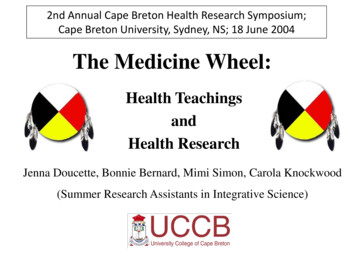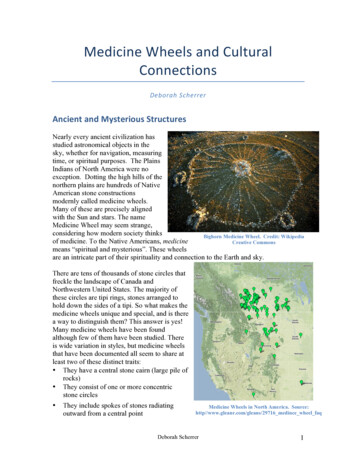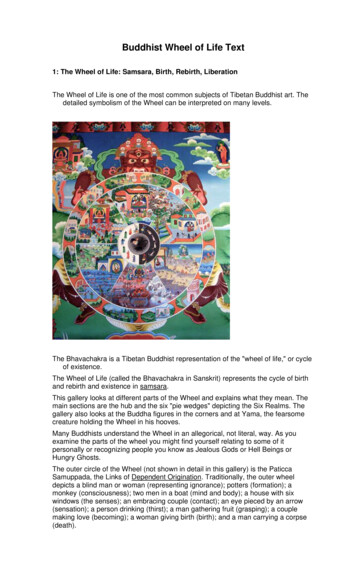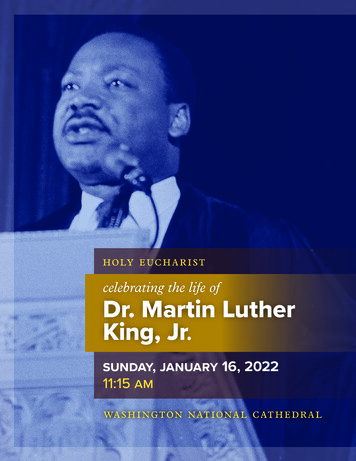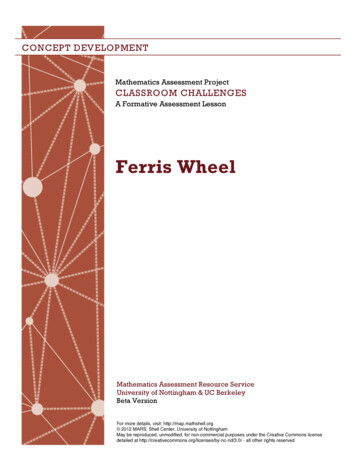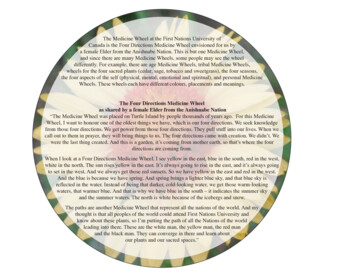
Transcription
The Medicine Wheel at the First Nations University ofCanada is the Four Directions Medicine Wheel envisioned for us bya female Elder from the Anishnabe Nation. This is but one Medicine Wheel,and since there are many Medicine Wheels, some people may see the wheeldifferently. For example, there are age Medicine Wheels, tribal Medicine Wheels,wheels for the four sacred plants (cedar, sage, tobacco and sweetgrass), the four seasons,the four aspects of the self (physical, mental, emotional and spiritual), and personal MedicineWheels. These wheels each have different colours, placements and meanings.The Four Directions Medicine Wheelas shared by a female Elder from the Anishnabe Nation“The Medicine Wheel was placed on Turtle Island by people thousands of years ago. For this MedicineWheel, I want to honour one of the oldest things we have, which is our four directions. We seek knowledgefrom those four directions. We get power from those four directions. They pull stuff into our lives. When wecall out to them in prayer, they will bring things to us. The four directions came with creation. We didn’t. Wewere the last thing created. And this is a garden, it’s coming from mother earth, so that’s where the fourdirections are coming from.When I look at a Four Directions Medicine Wheel, I see yellow in the east, blue in the south, red in the west,white in the north. The sun rises yellow in the east. It’s always going to rise in the east, and it’s always goingto set in the west. And we always get those red sunsets. So we have yellow in the east and red in the west.And the blue is because we have spring. And spring brings a lighter blue sky, and that blue sky isreflected in the water. Instead of being that darker, cold-looking water, we get those warm-lookingwaters, that warmer blue. And that is why we have blue in the south – it indicates the summer skyand the summer waters. The north is white because of the icebergs and snow.The paths are another Medicine Wheel that represent all the nations of the world. And mythought is that all peoples of the world could attend First Nations University andknow about these plants, so I’m putting the path of all the Nations of the worldleading into there. These are the white man, the yellow man, the red manand the black man. They can converge in there and learn aboutour plants and our sacred spaces.”
Common Name: Blanket flowerLatin Name: Gaillardia aristataCommon Name: Stiff goldenrodLatin Name: Solidago rigidaEastCommon Name: Prairie coneflowerLatin Name: Ratibida columniferayellowCommon Name: GumweedLatin Name: Grindelia squarrosaCommon Name: Hairy golden asterLatin Name: Chrysopsis villosaCommon Name: SneezeweedLatin Name: Helenium montanum orHelenium autumnale
Ny a male Elder from theStaared bndingas shBueelf“The most important part of thefalWhoFnemedicine wheel is the circle; we call it a hoop.ir world,atioeMnTh and the sky. The circle is important in that it develops an energy thatkeeps flowing and building momentum. Energy can continue to flowaround a circle forever. Sometimes we put a sick person in the middleof the circle. All of the people sitting around the circle are anequal distance from the person in the middle and theenergy focuses itself to the middle. You see, weall have a spirit, an energy that is transferable.We also get energy from nature, becauseall things that are alive, includingrocks, have energy to depart.”“The Medicine Wheel is a tool. Every morning I start out inthe east and move through the directions. I physicallymove as I go through the directions. ”-student at the First NationsUniversity of CanadaEach person must find their own Medicine Wheel.What colours do you see in each of the directions?What animals do you associate with each direction?What your Medicine Wheel is comes from yourown personal experience of it.by a male Elder fromsharedsthePaalsquah el until recently; we called it the SacredMe Circle. You see the Sacred Circle in so many things, like the tionhTrocks of the tipi and the talking circle. The circle also represents thetime from infants to old people. When old people start acting like kidsagain, they have completed the cycle. For me, the Medicine Wheelhas four quadrants: white faces North, yellow faces East,red faces South, and blue-green faces West. I think of the Xof the quadrants as a light that shines from thecentre. The beam spreads as it moves outand covers everything in thatdirection.”a female Elder from the Se d bytandirahng Bssaluffee“For the Dakota-Sioux, thehalWeMedicine Wheel is referred to as the Sacred Hoop. o Firnisticed It does not have the four quadrants as seen in the Medicineae M Wheels of other Nations but consists of simply the circle, the Sacred tionhTHoop. The sacred hoop holds the belief of equality, that everybody andeverything has equal value with nothing and nobody being worthmore or less than another. The Sacred Hoop also representsthe cycles of life. The seasons move in a circle fromspring to summer to fall to winter, and lifemoves in a circle from infants to youthto adults to old people.”
Common Name: Sweet grassLatin Name: Heirochloe odorataCommon Name: Wild mintLatin Name: Mentha arvensisCommon Name: AlumrootLatin Name: Heuchera richardsoniiSouthblue/greenCommon Name: Blue beardtongueLatin Name: Pentstemon nitidusCommon Name: Indian breadrootLatin Name: Psoralea esculentaCommon Name: Blue-eyed grassLatin Name: Sisyrinchium montanum
GrowthThe Seven Stonesas shared by a female Elder from the Anishnabe First Nation“Children gain things from knowing their identities from the time they are very young.Our language gives us that identity. Through our language, children gain things called theseven stones. The seven stones are growth, order, adequacy, love, security,social approval, and self-esteem.In our traditions, people give adequacy through demonstrating how we live our lives. For example,when my dad hunted, everybody got meat. We didn’t keep it at home and hoard it. And when wepicked berries, even the people that didn’t go picking got some, because there might have been a reasonthat they could not go. We shared, and knew the Creator would take care of us for another day. Sometimeschildren that are young take ownership of things. Living adequately says to you that you don’t have a need tohave ownership of something that can be bought or worn here are different forms of love. In our communities, we have an informal adoption of people. They are notbiologically related to me, but they are aunties, uncles, brothers or sisters, because, as two-leggeds, they areall in our family and it doesn’t matter if they are non-Aboriginal or not. The thing that is important to usis people. They may only be with us for that five minutes - so enjoy it.We demonstrate the stones to our children. When they turn 13 and get into that culture within aculture – that seven sacred years, they have all those stones built for them. They know who theyare and if you know what stones you are, then you aren’t going to grab onto a rock of falsebelief about yourself. That culture within a culture has been there for thousands of yearsand will be there if Mother Earth doesn’t stand up, shake her skirts, and drop us offwithin the next few years. That’s what the seven stones are for.”Love
Common Name: Prairie Smoke, Three-flowered avensLatin Name: Geum triflorumCommon Name: Scarlet mallowLatin Name: Malvastrum coccineumCommon Name: Purple coneflowerLatin Name: Echinacea angustifoliaWestRedCommon Name: Cut-leaved anemoneLatin Name: Anemone multifidaCommon Name: Dotted blazingstarLatin Name: Liatrus punctataCommon Name: Wild bergamot, horse mintLatin Name: Monarda fistulosa
The Tamarack tree was choosen for the seventrees because it reflects the changing of the seasonsand the cycles of life.“The number seven hassignificance within the Dakota-Sioux culture.The seventh generation is believed to be a time ofgreat change. This could include bringing back somethingfrom seven generations prior, such as a traditional practice orceremony, or an old way of understanding things.The number seven is also in the story of how the pipe was givento the people. Two men went hunting buffalo. A womanapproached them. She told the men to tell the people that shewould be bringing them a gift. She came to the peoplewith the sacred pipe and the 7 ways to live by.”-female Elder from the Standing BuffaloFirst Nation“The seven trees. Iwas told trees are likewomen, they lay down roots,they nourish, they protect, andthey bring forth young - their fruitand leaves are their young. Theseventh tree will be a memorial tothe missing women.”-female Elder from theAnishnabe Nation“The number seven is different fordifferent tribes. For us, it exists in the Seven CouncilFires for the Dakota, Lakota, and Nakota Nations. The SevenCouncil Fires are a political structure.And there are the seven ceremonies or sacrifices. These are theMaking of a Relative Ceremony, the Naming Ceremony, the SweatLodge, the Sundance (which is most important for us), Throwingthe Ball Ceremony (at puberty), the Vision Quest, and thePipe Ceremony.”-male Elder from the Standing BuffaloFirst Nation
Common Name: Prairie sageLatin Name: Artemisia ludovicianaCommon Name: Ground plumLatin Name: Astragalus crassicarpusNorthCommon Name: Pussy toesLatin Name: Antennaria apricaWhiteCommon Name: Common yarrowLatin Name: Achillea millefoliumCommon Name: Pasture sageLatin Name: Artemisisa frigida
BuffaloRockBuffaloRock“We call the stones ourgrandfathers. They were here whenthe earth was young. They have somuch knowledge and memory. Wesee the stones as having spirit andbeing alive.”“It is our belief that the buffalo ranwest, and the mountains opened up,and they have taken refuge thereuntil we start bringing back ournatural plants. When the plantscome back, the buffalowill return.”“The Buffalo Rock is shiny. It’swhere the buffalo would lean up and rubthemselves. People often pray and make offerings liketobacco on large rocks. Large rocks serve as a reminder that we dobigger things than we can handle. They are humbling. The Buffalo Rockis important because it was favoured by the buffalo. The Dakota are Buffalopeople, so the buffalo are very important to us. When we brought back the buffaloto Standing Buffalo, people were crying to see them. A wholistic sense of wellness wasreturned.” -male Elder from StandingBuffalo First Nation“On the prairie, the buffalowas the thing that all people lived off of. Theyneeded nothing else but the buffalo. They used everypart of the buffalo. Today our buffalo has beentransformed into education for our people. When you get youreducation, no one can take it away from you. With your education, you canprovide yourself with all the things the buffalo would have given us – food,clothing. Instead of chasing the buffalo, our young people better be chasingeducation. - female Elder from the Anishnabe Nation
Common Name: Canada anemoneLatin Name: Anemone canadensisCommon Name: Long-fruited anemoneLatin Name: Anemone cylindricaNorthWhiteCommon Name: Wild licoriceLatin Name: Glycyrrhiza lepidotacon’tCommon Name: Prairie crocusLatin Name: Anemone patensCommon Name: Northern bedstrawLatin Name: Galium boreale
“Some elders are comfortable with sharingplant knowledge and uses and some are not. The uses forsome plants are given to us to use through visions and dreams. Eachperson may be given different plants and they may be used in different ways andfor different purposes. We cannot say what a plant is used for in general because eachplant will do different things depending on the person who uses them. And wecannot say what we use the plants for because it is sacred knowledge. If we do so, we willlose their gifts. Then, when we go to use them to help people, they will no longer work.There is a difference between wild and planted plants. The plants and medicines that grow inthe wild are stronger and more powerful medicines, while those that are planted do not holdthat same strength. The same goes for natural versus worked land. Once a land has beenturned and worked by man, the plants that grow within it will not be as powerfulas those that grow in untouched land. It is important when planting orpicking any plant that we treat it with respect.”- female Elder from the Standing Buffalo FirstNation“The old people were very powerful. They had dreamsabout plants – what to use them for, how to prepare them, and whichplants to mix them with. They didn’t just go out into the world and experiment– they received instructions through their dreams.”- male Elder from the Pasqua First Nation
We offer many thanks to all the Elders who shared theirtime, knowledge, support and enthusiasm for this project.Dr. Fidji Gendron, Assistant Professor of Biologyfgendron@firstnationsuniversity.ca(306) 790-5950 ext. 3335Research Assistant and booklet design: Michelle BidenGardeners: Fidji Gendron, Malin Hansen, ThomasRoussin, Michelle Biden, Brandi Morris, students ofThom Collegiate, members of Aids Programs SouthSaskatchewan and Red Feather Spirit Lodge.Photographs: Fidji Gendron, Michelle Biden andSaskatchewan Conservation Data CentreThe Medicine Wheel Garden was created in the Summer of 2008.
“Female sage is aplant that grows forwomen and their physical,mental, emotional, and spiritualhealing. There is a story about a fatherwho had three beautiful daughters. Thedaughters would go and dance at night withall of the other women. There was a man whohad been watching the beautiful sisters. He toldtwo friends from another camp about their beautyand the next night the two men kidnapped twodaughters and took them back to their camp. Theother sister ran to her father and told him that hisdaughters had been taken. It was the darkness beforedawn and he knew he would have no chance of findinghis daughters that day. He waited until the nextevening and went to the spot where his daughters hadbeen taken. He put down tobacco and he prayed.Before him, there was a path of sage, glowing in themoonlight. The path showed the struggles of thewomen and he followed it straight to the tipiwhere the men were keeping his daughters. Hetook back his daughters and told the men thatif his daughters wanted to marry them,they were free to do so, but then thingsmust be done in the proper way.”-female Elder from theAnishnabeFirst Nation
The Medicine Wheel Garden issponsored byPRAIRIE HABITATSClint SanbornNorthern TreeWal-Mart EvergreenGreen GrantSaskatchewanWatershedAuthority
The Four Dir ections Medicine Wheel as shar ed by a female Elder from the Anishnabe Nation ÒThe Medicine Wheel was placed on T urtle Island by people thousands of years ago. For this Medicine Wheel, I want to honour one of the oldest things we have, which is our four directions. W e seek knowledge from those four directions.


